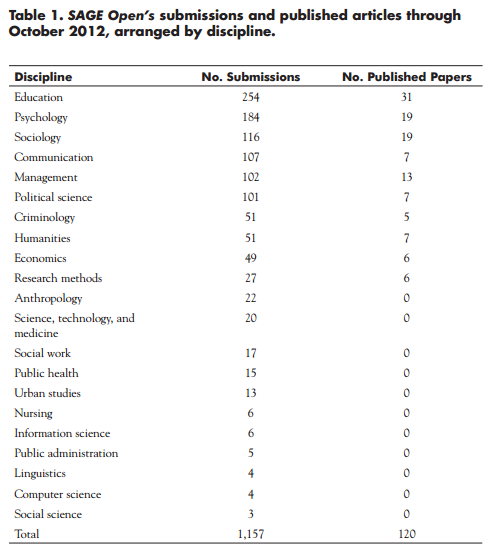Recent events, including the release of the Finch report in the UK and protest by a growing number of universities over rising periodical costs, have dramatically increased the awareness of open access (OA) in the humanities and social sciences (HSS). OA presents a number of unique challenges for HSS disciplines; such fields as communication studies and history cannot easily replicate OA policies or practices that are prevalent in science, technology, engineering, and mathematics (STEM) disciplines. Faced with the inevitability of an OA future, many HSS scholars are struggling to find a collective voice on how to adapt and reform scholarly communication in their fields (Nosek and Bar-Anan’s recent article in Psychological Inquiry is an excellent example1).
That is not to say that the HSS are anachronistic; some of the earliest OA journals were social science titles, including New Horizons in Adult Education, launched in 1987 by Syracuse University, and Stevan Harnad’s Psycoloquy, first published in1989 (and later sponsored by the American Psychological Association). The Social Science Research Network repository debuted in 1994, just 3 years after ArXiv. Today, the Directory of Open Access Journals lists just over 1,600 OA HSS titles, roughly 20% of the total number of titles listed.2
What challenges does OA present for HSS? A recent statement by the American Historical Association highlights many potential problems with adopting current OA models.3 For example, the association points out that many historians lack federal research funding that could offset gold OA article processing charges (APCs), and few institutions have funds set aside to pay APCs, so economically disadvantaged historians could be marginalized. The 2010 Study of Open Access Publishing (SOAP) project survey reinforces this assertion.4 Of roughly 38,000 HSS and STEM researchers surveyed, 39% of respondents indicated that they lacked funding to pay APCs. The SOAP survey also indicated that many social scientists are unaware of appropriate OA journals for their research and that many researchers are skeptical about the quality of OA journals. That skepticism is probably attributable to the fact that few, if any, HSS OA journals are ranked or are considered acceptable for promotion and tenure evaluations. In addition, many HSS publishers and societies are concerned that green OA publishing, in which articles published in subscription journals are deposited in an open repository, may jeopardize subscription revenues, on which many societies are dependent, particularly if articles are embargoed for any period less than 12 months.
SAGE discusses OA extensively with its HSS authors and societies, trying to find ways to overcome many of these challenges. SAGE is testing several OA models, including launching SAGE Open, a gold OA “mega-journal”; expanding the SAGE Choice program, a hybrid OA program that allows authors to pay to make their articles OA within a traditional subscription journal; and launching new OA journals with its partners.
SAGE Open launched in January 2011 as the first OA mega-journal to cover the HSS. Manuscripts are evaluated only on the basis of their research methods and scientific validity, not thematic significance. Authors pay an APC if their manuscript is accepted. As of this writing, the fee is $99. SAGE also considers hardship requests from authors. From its launch through the end of December 2012, SAGE Open received 1,390 submissions. Of those submissions, 76% received a final decision; of those that received a final decision, 16% were accepted, 45% were asked to submit a major or minor revision, and 39% were rejected. It is important to note that all papers are peer reviewed.
SAGE Open has quickly become one of SAGE’s most frequently accessed titles. In 2011, SAGE Open’s articles were downloaded over 51,600 times—an average of 782 downloads per article. By this metric, SAGE Open was the third-most frequently downloaded SAGE journal that year. The early successes suggest that a gold OA mega-journal may provide a viable solution for the HSS; however, more time is needed to confirm that.
OA is certain to be part of the scholarly communication landscape going forward, and the HSS will not be exempt from this shift. Many issues need to be resolved, most important how the cost of OA publishing can be supported in the HSS. SAGE and its society partners will continue to discuss and experiment with OA to find the most equitable and sustainable publishing model. In the meantime, SAGE will continue to advocate for more funding for HSS authors and will work with its partners in academe to help to usher in this new era in academic publishing.

References
- Nosek BA, Bar-Anan Y. Scientific utopia. Opening scientific communication. Psychol Inq. 2012; 23:217–243.
- Directory of Open Access Journals. http://www.doaj.org/doaj?func=subject&cpid=87.
- American Historical Association. AHA statement on scholarly journal publishing [press release]; 2012. http://blog.historians.org/news/1734/ahastatement-on-scholarly-journal-publishing.
- Dallmier-Tiessen S, Darby R, Goerner B, et al. 2011. Highlights from the SOAP project survey: what scientists think about open access publishing; 2011. http://arxiv.org/abs/1101.5260.
WILL SCHWEITZER is senior editor, journals, and CHARLES B CHOE is online product manager, SAGE Publications, Thousand Oaks, California.

